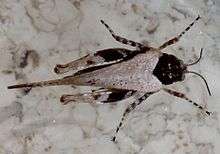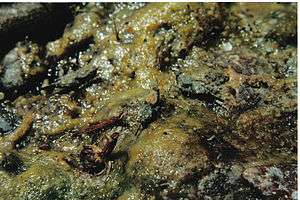Tetrigidae
| Tetrigidae | |
|---|---|
 | |
| Tetrix species | |
| Scientific classification | |
| Kingdom: | Animalia |
| Phylum: | Euarthropoda |
| Class: | Insecta |
| Order: | Orthoptera |
| Suborder: | Caelifera |
| Family: | Tetrigidae Rambur, 1838 |
| Subfamilies | |
| |
Tetrigidae[1] is a family in the order Orthoptera, which also includes similar families such as crickets, grasshoppers, and their allies. Species within the Tetrigidae are variously called groundhoppers,[2] pygmy grasshoppers[3] or (mostly historical) "grouse locusts".[4]
Diagnostic characteristics

Tetrigidae are typically less than 20 mm in length, and are recognizable by a long pronotum, that extends over the length of the abdomen, sometimes to the tip of the wings, and ends in a point.[3] In other Orthoptera, the pronotum is short and covers neither the abdomen nor the wings. Tetrigidae are generally cryptic in coloration.[5] Some species have enlarged pronota that mimic leaves, stones or twigs.[6]
General biology
In temperate regions, Tetrigidae are generally found along streams and ponds, where they feed on algae and diatoms.[7] The North American species Paratettix aztecus and Paratettix mexicanus, for example, depend on aquatic primary production for between 80% and 100% of their diet.[8] Riparian species are capable of swimming on the surface of the water, and readily leap into the water when alarmed[6] Some species in the tribe Scelimenini are fully aquatic and capable of swimming underwater.[7]
The highest biodiversity of Tetrigidae is found in tropical forests. Some tropical species are arboreal and live among mosses and lichens in tree buttresses or in the canopy,[7] while others live on the forest floor.[5]
Like other Orthoptera, Tetrigidae have a hemimetabolous development, in which eggs hatch into nymphs. Unlike other temperate Orthoptera, however, temperate Tetrigidae generally overwinter as adults.[3]
Some subfamilies within the Tetrigidae, such as the Batrachideinae, are sometimes elevated to family rank besides the Tetrigidae.

Genera and Etymology
The name may be derived from Latin tetricus or taetricus, meaning harsh, sour, severe.[9]
Approximately 1,600 species have been described; according to the Orthoptera Species File[10] the following genera are included:
- Batrachideinae Bolívar, 1887
- Apteropedon Bruner, 1910
- Ascetotettix Grant, 1956
- Batrachidea Serville, 1838
- Eutettigidea Hancock, 1914
- Halmatettix Hancock, 1909
- Lophoscirtus Bruner, 1911
- Palaisioscaria Günther, 1936
- Paurotarsus Hancock, 1900
- Paxilla Bolívar, 1887
- Phloeonotus Bolívar, 1887
- Plectronotus Morse, 1900
- Puiggaria Bolívar, 1887
- Rehnidium Grant, 1956
- Saussurella Bolívar, 1887
- Scaria Bolívar, 1887
- Tettigidea Scudder, 1862
- Vilma Steinmann, 1973
- Vingselina Sjöstedt, 1921
- Cladonotinae Bolívar, 1887
- Afrolarcus Günther, 1979
- Antillotettix Perez-Gelabert, 2003
- Austrohancockia Günther, 1938
- Bahorucotettix Perez-Gelabert, Hierro & Otte, 1998
- Choriphyllum Serville, 1838
- Cladonotella Hancock, 1909
- Cladonotus Saussure, 1862
- Cota (Orthoptera) Bolívar, 1887
- Cubanotettix Perez-Gelabert, Hierro & Otte, 1998
- Cubonotus Perez-Gelabert, Hierro & Otte, 1998
- Dasyleurotettix Rehn, 1904
- Deltonotus Hancock, 1904
- Diotarus Stål, 1877
- Dolatettix Hancock, 1907
- Eleleus Bolívar, 1887
- Epitettix Hancock, 1907
- Fieberiana Kirby, 1914
- Gestroana Berg, 1898
- Gignotettix Hancock, 1909
- Haitianotettix Perez-Gelabert, Hierro & Otte, 1998
- Hancockella Uvarov, 1940
- Hippodes Karsch, 1890
- Hottettix Perez-Gelabert, Hierro & Otte, 1998
- Hymenotes Westwood, 1837
- Hypsaeus Bolívar, 1887
- Microthymochares Devriese, 1991
- Misythus Stål, 1877
- Mucrotettix Perez-Gelabert, Hierro & Otte, 1998
- Nesotettix Holdhaus, 1909
- Oxyphyllum Hancock, 1909
- Paraphyllum Hancock, 1913
- Paraxelpa Sjöstedt, 1932
- Pelusca Bolívar, 1912
- Phyllotettix Hancock, 1902
- Piezotettix Bolívar, 1887
- Potua Bolívar, 1887
- Pseudogignotettix Liang, 1990
- Pseudohyboella Günther, 1938
- Sierratettix Perez-Gelabert, Hierro & Otte, 1998
- Stegaceps Hancock, 1913
- Tepperotettix Rehn, 1952
- Tettilobus Hancock, 1909
- Thymochares Rehn, 1929
- Tiburonotus Perez-Gelabert, Hierro & Otte, 1998
- Tondanotettix Willemse, 1928
- Truncotettix Perez-Gelabert, Hierro & Otte, 1998
- †Baeotettix Heads, 2009
- Cleostratinae Hancock, 1907
- Cleostratus Stål, 1877
- Discotettiginae Hancock, 1907
- Amphinotus Hancock, 1904
- Discotettix Costa, 1864
- Hydrotetrix Uvarov, 1926
- Lamellitettigodes Günther, 1939
- Paraguelus Günther, 1939
- Spartolus Stål, 1877
- Arulenus Stål, 1877
- Hirrius Bolívar, 1887
- Lophotettiginae Hancock, 1909
- Lophotettix Hancock, 1909
- Phelene Bolívar, 1906
- Metrodorinae Bolívar, 1887
- Allotettix Hancock, 1899
- Amorphopus Serville, 1838
- Andriana (genus) Rehn, 1929
- Apterotettix Hancock, 1904
- Arexion (genus) Rehn, 1929
- Austrohyboella Rehn, 1952
- Bara (insect) Rehn, 1929
- Bullaetettix Günther, 1937
- Calyptraeus Wang, 2001
- Camelotettix Hancock, 1907
- Centrosotettix Günther, 1939
- Charagotettix Brancsik, 1893
- Chiriquia Morse, 1900
- Cingalina Hebard, 1932
- Cingalotettix Günther, 1939
- Corystotettix Günther, 1939
- Cotys (genus) Bolívar, 1887
- Cotysoides Zheng & Jiang, 2000
- Crimisodes Hebard, 1932
- Crimisus Bolívar, 1887
- Cryptotettix Hancock, 1900
- Eomorphopus Hancock, 1900
- Eurybiades (genus) Rehn, 1929
- Eurymorphopus Hancock, 1907
- Hildegardia Günther, 1974
- Holocerus Bolívar, 1887
- Hovacris Rehn, 1929
- Hybotettix Hancock, 1900
- Hyperyboella Günther, 1938
- Indomiriatra Tinkham, 1939
- Isandrus Rehn, 1929
- Macromotettix Günther, 1939
- Macromotettixoides Zheng, Wei & Jiang, 2005
- Mazarredia Bolívar, 1887
- Melainotettix Günther, 1939
- Metamazarredia Günther, 1939
- Metopomystrum Günther, 1939
- Metrodora (genus) Bolívar, 1887
- Miriatra Bolívar, 1906
- Miriatroides Zheng & Jiang, 2002
- Moluccasia Rehn, 1948
- Myxohyboella Shishodia, 1991
- Notocerus Hancock, 1900
- Ocytettix Hancock, 1907
- Ophiotettix Walker, 1871
- Orthotettix Hancock, 1909
- Orthotettoides Zheng, 1998
- Otumba (genus) Morse, 1900
- Oxytettix Rehn, 1929
- Paraspartolus Günther, 1939
- Platythorus Morse, 1900
- Plesiotettix Hancock, 1907
- Procytettix Bolívar, 1912
- Pseudomitraria Hancock, 1907
- Pseudoparatettix Günther, 1937
- Pterotettix Bolívar, 1887
- Rhopalina Tinkham, 1939
- Rhopalotettix Hancock, 1910
- Rhynchotettix Hancock, 1907
- Salomonotettix Günther, 1939
- Scabrotettix Hancock, 1907
- Spadotettix Hancock, 1910
- Synalibas Günther, 1939
- Systolederus Bolívar, 1887
- Threciscus Bolívar, 1887
- Thyrsus (genus) Bolívar, 1887
- Timoritettix Günther, 1971
- Trigonofemora Hancock, 1906
- Vaotettix Podgornaya, 1986
- Scelimeninae Hancock, 1907
- Criotettigini Kevan, 1966
- Criotettix Bolívar, 1887
- Euloxilobus Sjöstedt, 1936
- Loxilobus Hancock, 1904
- Tettitelum Hancock, 1915
- Scelimenini Hancock, 1907
- Amphibotettix Hancock, 1906
- Eufalconius Günther, 1938
- Euscelimena Günther, 1938
- Falconius Bolívar, 1898
- Gavialidium Saussure, 1862
- Hexocera Hancock, 1915
- Indoscelimena Günther, 1938
- Paragavialidium Zheng, 1994
- Paramphibotettix Günther, 1938
- Platygavialidium Günther, 1938
- Scelimena Serville, 1838
- Tagaloscelimena Günther, 1938
- Tefrinda Bolívar, 1906
- Tegotettix Hancock, 1913
- Thoradontini Kevan, 1966
- Bolivaritettix Günther, 1939
- Bolotettix Hancock, 1907
- Eucriotettix Hebard, 1930
- Hebarditettix Günther, 1938
- Probolotettix Günther, 1939
- Rostella Hancock, 1913
- Syzygotettix Günther, 1938
- Thoradonta Hancock, 1909
- Xistra Bolívar, 1887
- Xistrella Bolívar, 1909
- Xistrellula Günther, 1939
- tribe unassigned:
- Eufalconoides Zheng, Li & Shi, 2003
- Hyboella Hancock, 1915
- Zhengitettix Liang, 1994
- Criotettigini Kevan, 1966
- Tetriginae Serville, 1838
- Dinotettigini Günther, 1979
- Afrocriotettix Günther, 1938
- Dinotettix Bolívar, 1905
- Ibeotettix Rehn, 1930
- Lamellitettix Hancock, 1904
- Marshallacris Rehn, 1948
- Pseudamphinotus Günther, 1979
- Tetrigini Serville, 1838
- Clinotettix Bei-Bienko, 1933
- Coptotettix Bolívar, 1887
- Euparatettix Hancock, 1904
- Exothotettix Zheng & Jiang, 1993
- Paratettix Bolívar, 1887
- Tetrix (insect) Latreille, 1802
- Thibron (genus) Rehn, 1939
- tribe unassigned:
- Alulatettix Liang, 1993
- Ankistropleuron Bruner, 1910
- Bannatettix Zheng, 1993
- Bienkotetrix Karaman, 1965
- Bufonides Bolívar, 1898
- Carolinotettix Willemse, 1951
- Coptottigia Bolívar, 1912
- Cranotettix Grant, 1955
- Depressotetrix Brisout de Barneville, 1848 ou Karaman, 1960
- Ergatettix Kirby, 1914
- Flatocerus Liang & Zheng, 1984
- Formosatettix Tinkham, 1937
- Formosatettixoides Zheng, 1994
- Gibbotettix Zheng, 1992
- Hedotettix Bolívar, 1887
- Heteropterus Wang, 1992
- Leptacrydium Chopard, 1945
- Macquillania Günther, 1972
- Micronotus Hancock, 1902
- Neocoptotettix Shishodia, 1984
- Neotettix Hancock, 1898
- Nomotettix Morse, 1894
- Ochetotettix Morse, 1900
- Phaesticus Uvarov, 1940
- Sciotettix Ichikawa, 2001
- Stenodorus Hancock, 1906
- Teredorus Hancock, 1907
- Tettiella Hancock, 1909
- Tettiellona Günther, 1979
- Uvarovitettix Bazyluk & Kis, 1960
- Xiaitettix Zheng & Liang, 1993
- Dinotettigini Günther, 1979
- Tripetalocerinae Hancock, 1907
- Tripetalocera Westwood, 1834
- Birmana Brunner von Wattenwyl, 1893
- Kraengia Bolívar, 1909
- sub-family unassigned:
- Xerophyllini Günther, 1979
- Acmophyllum Karsch, 1890
- Astyalus Rehn, 1939
- Cladoramus Hancock, 1907
- Morphopoides Rehn, 1930
- Morphopus Bolívar, 1905
- Pantelia Bolívar, 1887
- Paulytettix Devriese, 1999
- Royitettix Devriese, 1999
- Sanjetettix Devriese, 1999
- Seyidotettix Rehn, 1939
- Trachytettix Stål, 1876
- Trypophyllum Karsch, 1890
- Xerophyllum Fairmaire, 1846
- Xerophyllini Günther, 1979
- sub-family unassigned:
- Aalatettix Zheng & Mao, 2002
- Bidentatettix Zheng, 1992
- Castetsia Bolívar, 1902
- Christa Rehn, 1914
- Cyphotettix Rehn, 1952
- Lepocranus Devriese, 1991
- Paramphinotus Zheng, 2004
- Peronotettix Rehn, 1952
- Pseudepitettix Zheng, 1995
- Pseudosystolederus Günther, 1939
- Pseudoxistrella Liang, 1991
- Rehnitettix Günther, 1939
- Rosacris Bolívar, 1931
- Silanotettix Günther, 1959
- Tuberfemurus Zheng, 1992
- Yunnantettix Zheng, 1995
- †Archaeotetrix Sharov, 1968
- †Prototetrix Sharov, 1968
References
- ↑ Rambur (1838) Faune entomologique de l'Andalousie 2:64
- ↑ Ragge DR (1965). Grasshoppers, Crickets & Cockroaches of the British Isles. F Warne & Co, London. p. 299.
- 1 2 3 Borror DJ, Tripplehorn CA, Johnson NF (1989) An Introduction to the Study of Insects, 6th edition. Harcourt Brace College Publishers. New York. pg 213
- ↑ Imms AD, rev. Richards OW & Davies RG (1970) A General Textbook of Entomology 9th Ed. Methuen 886 pp.
- 1 2 Grimaldi D, Engel MS (2005) Evolution of the Insects. Cambridge University Press, Cambridge. pg 211
- 1 2 Preston-Mafham K (1990) Grasshoppers and Mantids of the World. Facts of File, New York. pg 32
- 1 2 3 Resh VH, Cardé RT (2003) Encyclopedia of Insects. Academic Press, Amsterdam, pg 839
- ↑ Bastow JL, Sabo JL, Finlay JC, Power ME (2002) A basal aquatic-terrestrial trophic link in rivers: algal subsidies via shore-dwelling grasshoppers. Oecologia 131: 261–268
- ↑ "Family Tetrigidae - Pygmy Grasshoppers".
- ↑ Orthoptera Species File (retrieved 30 March 2010)
External links


- Pygmy locusts
- Pygmy grasshoppers
- BugGuide.net